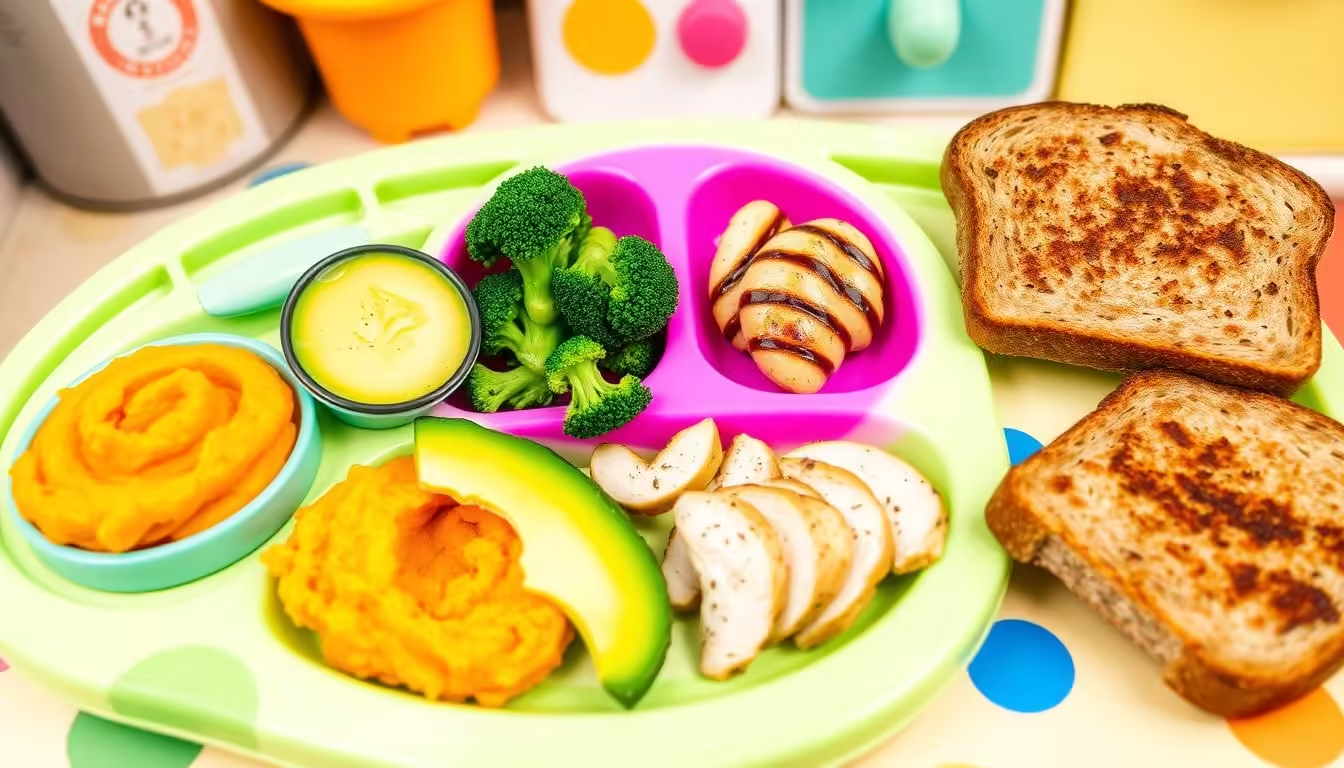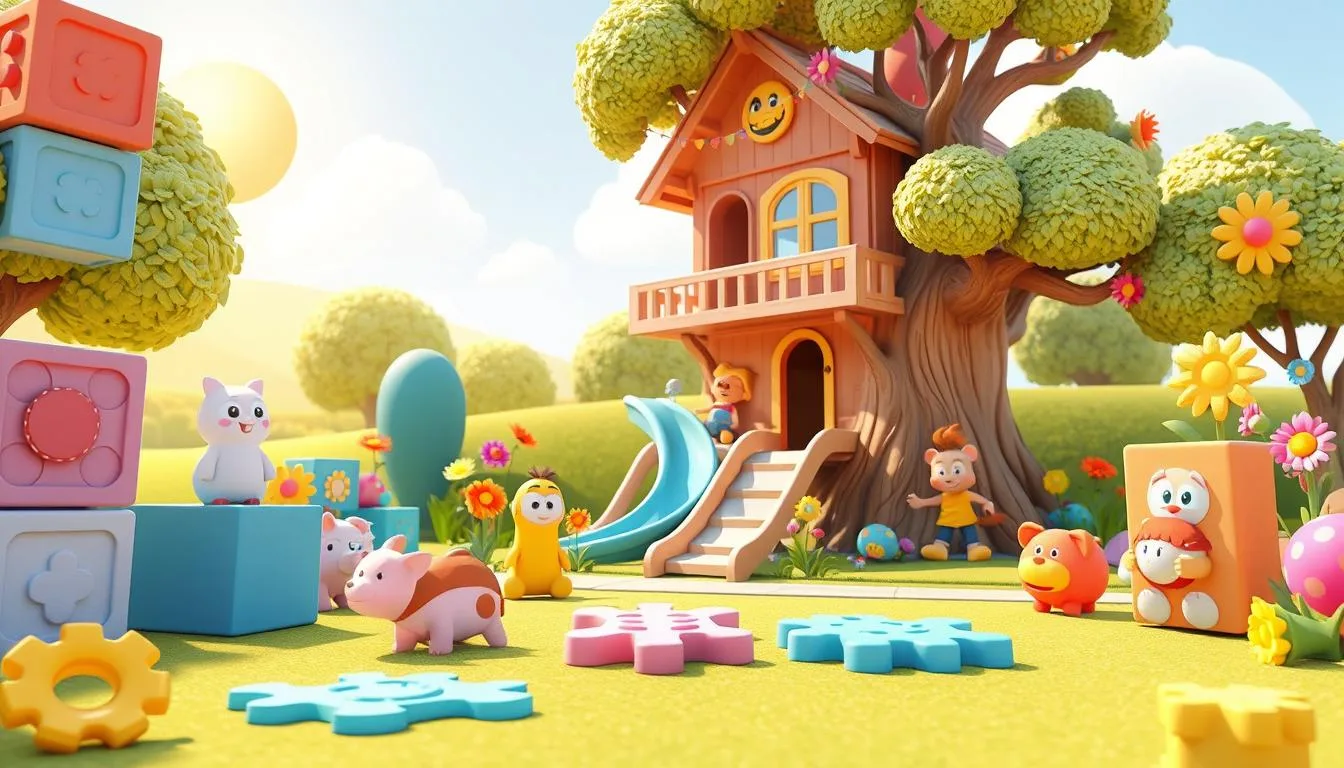Feeding a 1-year-old the right foods is key for their growth. Toddlers need a mix of calories, protein, fats, vitamins, and minerals. This helps their bodies and minds grow fast. We’ll look at meals, snacks, and ways to feed your 1-year-old to make sure they get all the nutrients they need.
Key Takeaways
- Toddlers aged 1 year old require around 1,000 calories per day, with half of those calories coming from healthy fats.
- Offer a variety of nutrient-dense foods, including fruits, vegetables, whole grains, lean proteins, and dairy products.
- Introduce new foods gradually, as it may take up to 10 tries for a child to get used to new flavors and textures.
- Provide appropriate finger foods and snacks to support your child’s growing independence and exploration of solid foods.
- Monitor your child’s growth and adjust their food intake as needed, rather than focusing on specific meal-by-meal or day-to-day amounts.
Age-Appropriate Nutrition for 1-Year-Olds
When your little one turns one, their diet needs change to support their growth. They need about 1,000 calories a day, spread over three meals and two snacks. This helps them get all the nutrients they need.
Understanding Caloric and Nutrient Needs
Toddlers might eat differently each day. Their appetite and food likes can change. It’s important to offer a variety of foods that are good for their health.
The Importance of Healthy Fats and Nutrient-Dense Foods
Healthy fats are very important at this age. They give energy and help with brain, eye, and nervous system growth. Try to add foods like avocado, olive oil, nut butters, dairy, and fish to their meals and snacks.
| Food Group | Recommended Servings for Toddlers (1-2 years) |
|---|---|
| Fruits | 1/2 serve per day |
| Vegetables | 2-3 serves per day |
| Grains | 4 serves per day |
| Dairy | 1-1/2 serves per day |
| Protein | 1 serve per day |
Knowing your child’s calorie and nutrient needs helps them stay healthy and active.
Breakfast Ideas for 1-Year-Olds
Starting the day with a healthy breakfast is key for a 1-year-old’s energy and growth. There are many tasty and nutritious options to start their day off right. From cereals to egg dishes, these meals are perfect for busy toddlers.
Wholesome and Nutritious Morning Meals
Here are some healthy breakfast ideas for your 1-year-old:
- Iron-fortified cereal with whole milk and fresh fruit like bananas, strawberries, or peaches
- Scrambled eggs served with whole-wheat toast and a side of avocado or roasted sweet potato
- Overnight oats made with oats, milk, and your child’s favorite berries or diced pears
- Baked oatmeal with cinnamon, nuts, and a drizzle of maple syrup
- Egg muffins filled with veggies like spinach, bell peppers, and onions
- Breakfast burritos with whole-grain tortillas, scrambled eggs, and black beans
These meals offer a mix of protein, carbs, and fats. They help keep your toddler full and focused in the morning.
| Nutrient | Importance for Toddlers | Food Sources |
|---|---|---|
| Choline | Supports brain development and cognitive function | Eggs, meat, poultry, fish, dairy products |
| Fiber | Promotes healthy digestion and reduces disease risk | Whole grains, fruits, vegetables, nuts, and seeds |
| Antioxidants | Protect cells from damage and support immune function | Fruits, vegetables, spices like cinnamon |
Adding these healthy breakfasts to your 1-year-old’s day helps them stay active and focused. It’s a great way to support their growth and well-being.
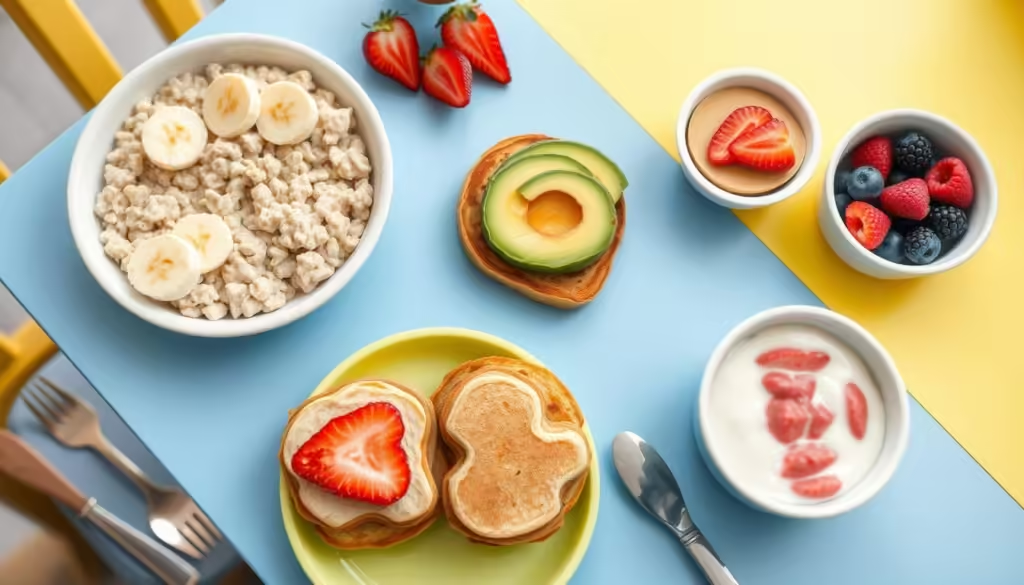
Lunch Meal Ideas for Toddlers
Creating a healthy lunch for your 1-year-old is fun. It’s a chance to add more veggies, protein, and whole grains. A good lunch idea for 1 year old is a half sandwich with turkey or chicken, tuna, or egg salad. Add cooked green veggies and whole milk for a complete meal.
Another healthy toddler lunch is pasta with ground meat and veggies. Or, try cubed cheese, sliced fruit, and whole-grain crackers. These easy toddler lunch recipes offer a balanced meal for your child.
Toddlers from 1 to 3 years old might be picky eaters. Their growth slows down, affecting their hunger and nutrition needs. Tailor lunch portions to their taste, appetite, and ability to chew.
Keep introducing foods they don’t like to help them try new things. Offering a variety of tastes and textures helps them develop good eating habits.
| Lunch Idea | Prep Time | Cook Time | Total Time | Calories | Servings |
|---|---|---|---|---|---|
| Spinach Grilled Cheese | 10 minutes | 6 minutes | 16 minutes | 157 kcal | 2 |
Spinach Grilled Cheese:
- 2 cups baby spinach
- 1/2 cup shredded cheddar cheese
- 1 tablespoon cream cheese
- 1/4 teaspoon cumin
- 4 pieces whole grain bread
- 1 tablespoon butter
“Lunchbox meals for toddlers should ideally include protein, fats, colorful fruits, and vegetables to sustain energy levels throughout the day.”
Dinner Recipes for 1-Year-Old Babies
Dinnertime is a great chance to introduce new tastes and textures to your 1-year-old. Try to make meals balanced with 2-3 ounces of cooked meat or poultry. Add cooked veggies and a whole-grain like brown rice or mashed potatoes. You can also bake salmon with sweet potatoes and broccoli, or make a lentil and vegetable stew.
Balanced and Flavorful Evening Meals
For dinner ideas for 1 year old, aim for nutritious toddler meals that taste good and are simple to make. Toddler dinner recipes can be comforting and loved by your little one. They help your child’s taste buds grow.
| Recipe | Ingredients | Preparation |
|---|---|---|
| Pumpkin Alfredo | Whole-wheat pasta, pumpkin puree, low-fat cream cheese, garlic, parmesan | Blend pumpkin, cream cheese, and garlic; toss with cooked pasta and parmesan. |
| Mac and Cheese Bites | Whole-wheat macaroni, low-fat cheddar, eggs, breadcrumbs | Mix cooked mac and cheese with eggs and breadcrumbs; bake into bite-sized portions. |
These dinner ideas for 1 year old are not just tasty but also packed with nutrients. They help your toddler try new flavors and textures. Letting your child help with cooking can make them love food more.
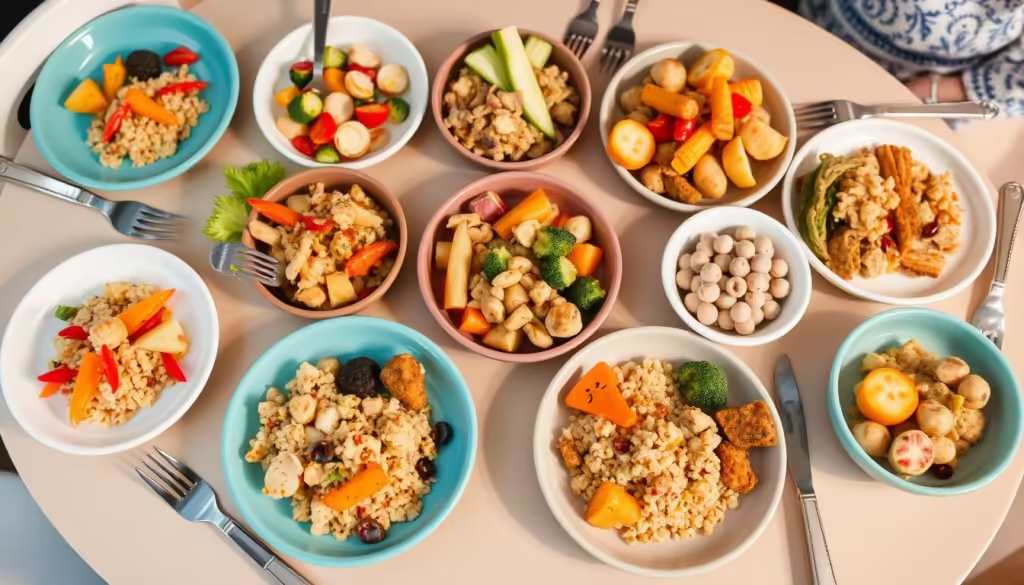
“Offering a variety of healthy, flavorful meals is key to establishing good eating habits in toddlers.”
Finger Foods and Snacks for 1-Year-Olds
As your 1-year-old gets better at using their fingers and feeding themselves, it’s time for finger foods and snacks. Soft, fresh fruit, crisp veggies, and dairy are great because they’re easy to eat. But remember, small pieces and no choking hazards are key.
Healthy Bite-Sized Treats and Nibbles
Finger foods for 1-year-olds should be fun and nutritious. They can have different tastes and textures to excite their senses. Here are some healthy choices:
- Dairy: Shredded or diced cheese, cottage cheese on spoons or trays
- Meat/Poultry/Fish: Shredded meats, deli meats, fish sticks, and soft, diced fish
- Legumes/Nuts: Chickpeas, edamame, energy bites, hummus, Larabars minis, and chopped nuts (for kids 2 and up)
- Whole Grains: Applesauce Pancakes, Baked French toast, Cheesy Rice, Oatmeal, Quinoa, and homemade bars
- Fruit: Apples, bananas, blackberries, blueberries, and more
- Vegetables: Avocado, broccoli, butternut squash, and more
Most parents see finger foods as a big part of their child’s diet. They say their toddlers love fruits and veggies the most. Offering a variety of healthy snacks helps your child grow strong and healthy.
meal ideas for 1 year old
Practical and Nutritious Meal Planning Tips
Creating healthy meals for your 1-year-old can be both rewarding and challenging. But, with some smart strategies, you can make it easier. Start by cooking proteins, grains, and veggies in bulk. This way, you can quickly make meals.
Try adding your child’s favorite foods to new recipes. It’s okay to serve the same healthy meals over and over. Sometimes, it takes many tries for a toddler to like a new food.
Planning meals is crucial to ensure your 1-year-old gets all the nutrients they need. Create a meal plan for the week or month. This helps you cover all food groups and offer different tastes and textures. Frozen fruits and veggies are great for adding variety to your meals.
There are countless healthy meals you can make for your toddler. Think about making homemade vegetable soup or shepherd’s pie. You can also try black beans and rice. Don’t be shy to try new ingredients and flavors. Your toddler might be more open to new foods than you think.
| Meal Idea | Nutritional Benefits |
|---|---|
| Hummus and Crackers | Protein-rich hummus paired with whole-grain crackers provides a balanced snack or mini-meal. |
| Peanut Butter Sandwich | Peanut butter offers healthy fats and protein to fuel growing bodies, while whole-wheat bread adds complex carbohydrates. |
| Roasted Vegetables | Roasting brings out the natural sweetness in vegetables, making them more appealing to toddlers while preserving their nutritional value. |
The secret to great toddler meal planning is balance, variety, and patience. With a bit of creativity and a well-stocked pantry, you can offer your 1-year-old many tasty and healthy meals. These meals will help them grow and develop well.
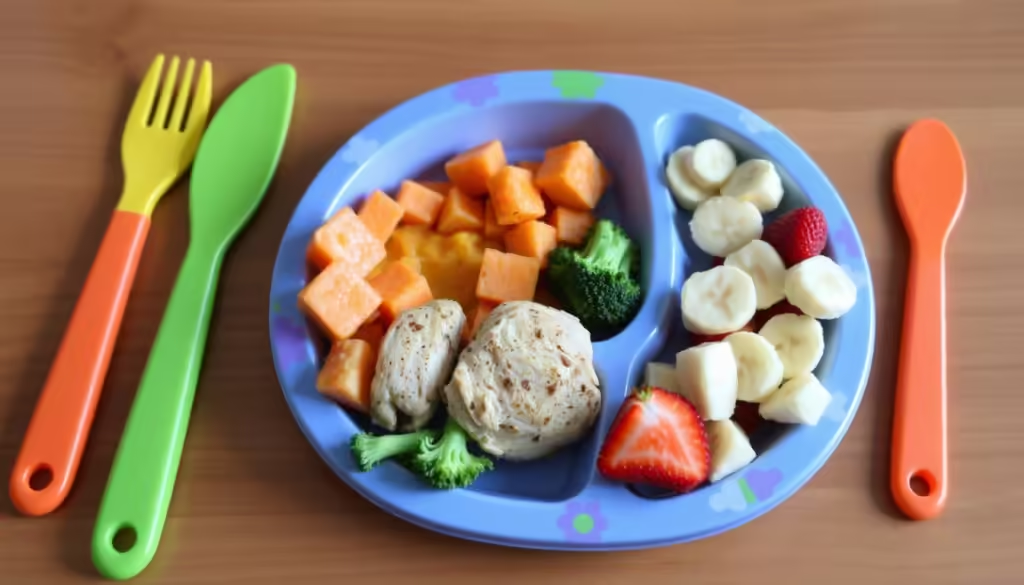
Introducing New Foods to Toddlers
Starting your 1-year-old on new foods can take time. They might not like new tastes and textures at first. Be patient and keep offering the same food until they get used to it. It can take up to 15 times before they accept something new.
Also, watch out for common allergens like peanuts, tree nuts, eggs, and dairy. Introduce these foods one at a time. This way, you can spot any allergic reactions early on.
Strategies for Picky Eaters and Allergen Awareness
One-year-olds have small stomachs, so every bite counts. They need foods rich in iron, dark greens, oranges, fats, proteins, and energy. Make sure to include a protein source at every meal and snack.
Foods high in vitamin C help absorb iron better. Give fruits and veggies with vitamin C at every meal and snack. Foods like grains, starchy veggies, and fruits give kids the energy they need to grow.
Be careful with foods that can be choking hazards, like whole grapes, popcorn, nuts, and hot dogs. Toddlers decide how much to eat, so don’t worry about portion sizes. Offer a variety of foods to meet their nutritional needs and likes.
It might take 8-15 times for a toddler to even try a new food. Show them how to eat by eating yourself. Watch their hunger cues to adjust meal times. Start with small portions to avoid overwhelming them.
Toddlers may resist eating if they feel forced. They might go through phases where they’re less hungry. Comparing new foods to foods they already like can make them more open to trying new things.
Using fun language about food can spark their interest. Family-style meals give them a sense of control. It’s normal for kids to be picky as they learn about food.
“Introducing new foods to a 1-year-old requires patience and persistence. Offering the same food multiple times, being mindful of allergens, and creating a positive mealtime environment can help picky eaters become more adventurous with their food choices.”
Drinks and Hydration for 1-Year-Olds
Keeping your 1-year-old well-hydrated is key. They need 700-1000 ml of fluid each day. Whole milk is great because it has fats, protein, and calcium.
Water is also good, but juice and sugary drinks should be rare. They can take the place of better foods and harm teeth.
Drinking enough helps your toddler grow and stay healthy. The American Academy of Pediatrics says 2 cups of cow’s milk a day is enough for kids 12-24 months. Fruit juice should be less than 4 fluid ounces daily.
Toddlers need 1,000–1,400 calories a day. Make sure they get the right nutrients. Avoid sugary drinks like sodas and fruit drinks. Water should be their main drink all day.
| Recommended Drinks for 1-Year-Olds | Amounts to Limit |
|---|---|
|
|
It’s important to keep your toddler hydrated and away from sugary drinks. Talk to your pediatrician if you’re worried about their drinking habits.
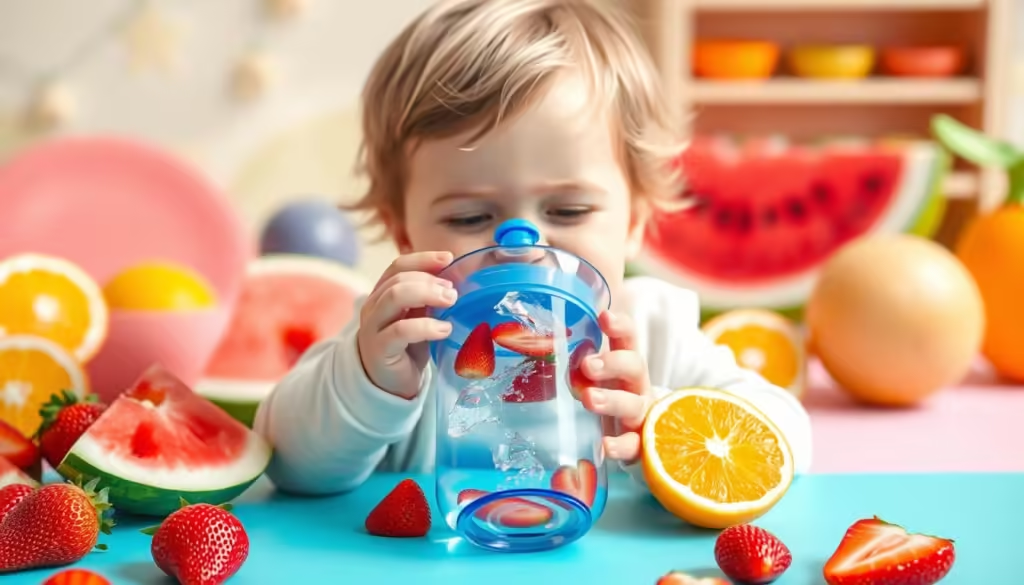
“Proper hydration is essential for 1-year-olds, who should be drinking between 700-1000 ml of fluid per day.”
Meal Prep and Planning for Busy Parents
Getting healthy meals ready for your 1-year-old can take a lot of time. But, with some smart toddler meal prep tips, you can make it faster. Try batch cooking. This means making proteins, grains, and veggies in big batches. Then, you can mix and match them to make quick, balanced easy toddler meals all week.
Freezing meals like purees, soups, and casseroles is another great idea. These frozen meals are perfect for busy days when you need something fast and easy.
Planning your meals and making a shopping list for the week can also help. This way, you know exactly what you need and avoid last-minute trips to the store.
“Most Sundays are spent getting organized for the week ahead, indicating a weekly meal prep routine for busy parents.”
When you go shopping, look for loose produce and sales. This can save you money and let you use fresh, seasonal ingredients in your meals.
Organizing your meal planning can also make things easier. Try grouping meals by type or cooking parts of meals ahead of time. This makes toddler meal prep more efficient and less stressful.
The secret to great toddler meal prep is finding a balance. Be ready to change plans if needed, and keep things like frozen veggies and sauces handy. They can make your easy toddler meals even quicker and easier.
Conclusion
It’s key to give your 1-year-old the right toddler nutrition and healthy toddler meals. Knowing their 1 year old feeding guide helps a lot. You can make sure they eat well by mixing different foods and planning meals smartly.
Being patient and creative at mealtime is important. It helps your child love eating healthy, tasty foods. This way, mealtimes become a chance to teach them about good food.
It might take time for your child to like new tastes and textures. But don’t worry, keep introducing them to lots of healthy foods. Soon, they’ll enjoy trying different things. Making mealtime fun helps them learn to eat well for life.
With the right toddler nutrition plan, your 1-year-old will have all the energy they need. Enjoy trying new healthy toddler meals together. Watch as your child grows into a confident, healthy eater.
FAQ
What are some healthy and nutritious meal ideas for a 1-year-old?
For breakfast, try iron-fortified cereal with whole milk, scrambled eggs, and whole-wheat toast with nut butter. Add fresh fruit for a sweet touch. Lunch can be a half sandwich with protein, veggies, and whole milk.
Dinner should have 2-3 ounces of cooked meat or poultry. Pair it with veggies and a whole-grain like brown rice or mashed potatoes.
How many calories does a 1-year-old need per day?
One-year-olds need about 1,000 calories daily. Their diet should have protein, healthy fats, complex carbs, and lots of vitamins and minerals.
What are some healthy fats and nutrient-dense foods that should be included in a 1-year-old’s diet?
Include avocado, olive oil, nut butters, dairy, and fish in their diet. These foods give essential energy and help with brain, eye, and nervous system growth.
What are some good finger food and snack options for a 1-year-old?
Good snacks include soft, fresh fruit like bananas, peaches, and berries. Also, try veggie sticks, cheese cubes, and unsweetened yogurt.
How can parents make meal planning and preparation easier for a 1-year-old?
Batch cooking proteins, grains, and veggies can save time. Freeze homemade purees, soups, and casseroles for later. Plan weekly menus and make a grocery list to stay organized.
How should parents introduce new foods to a 1-year-old?
Introduce new foods slowly, as they might not like them at first. Be patient and keep offering the same food until they accept it. Start with small amounts and watch for any signs of allergy.
How much fluid should a 1-year-old be drinking per day?
One-year-olds need 700-1000 ml of fluid daily. Whole milk is great because it has fats, protein, and calcium. Water is okay too, but limit juice and sugary drinks.

